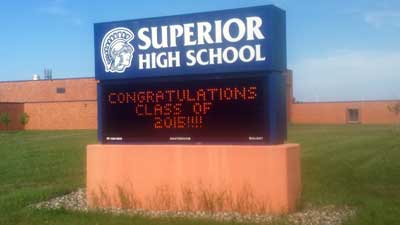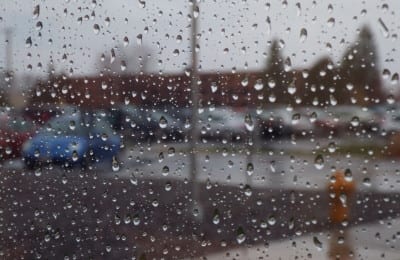Return on Investment
Reprinted with permission of Positively Superior, June/July Issue
By Holly Kelsey-Henry

Superior High School
When voters in the Superior School District go to the polls in April 2016, they’ll be asked to make a major investment in the district’s students.
A comprehensive facilities study completed in April of 2014 by architectural and design firm LHB Inc., Kraus-Anderson Construction Co. and the McKinstry Energy Efficiency firm revealed significant deficiencies at a number of the district’s schools. Among other things, the study called for complete replacement of Cooper Elementary School and an addition and major renovations for Superior High School.
The report also determined the need for new roofs at Great Lakes Elementary and Bryant Elementary and noted deficiencies at Four Corners Elementary, Lake Superior Elementary, Northern Lights Elementary, Superior
“The school is obsolete in the sense that maintenance and repair costs for work that would be necessary to get the building into like-new shape would be a large percentage of the actual replacement [cost].” – Gary Niemi, Dir.of Buildings and Grounds, School District of Superior, re. Cooper Elementary School.
Middle School and at school forest buildings. Many of these deficiencies are similar, including: lighting that is not energy efficient; a need for new paving to provide separate drop-off areas for bused students and those whose parents drive them (to reduce congestion and improve safety); flooring near at the end of its useful life; HVAC (heating, ventilation and air conditioning) and mechanical system controls that are wearing out; old windows that create water seepage and mold/mildew problems; and exterior wall mortar and caulk joint deterioration.

Superior Middle School
Classroom buildings at the school forest need flooring replaced and the entry drive needs a gravel surface and turnaround area, so buses don’t need to back down the driveway.
According to Gary Niemi, the school district’s director of buildings and grounds, there are numerous problems at both Cooper and Superior High that present safety concerns and impair the learning experience for students.
“At Cooper Elementary School, we are concerned with a number of issues that affect the usability of the school as well as its ability to provide a quality learning environment,” he said. “First, the school is obsolete in the sense that maintenance and repair costs for work that would be necessary to get the building into like-new shape would be a large percentage of the actual replacement [cost].”

Weisberg Memorial Center
Niemi said that at the time the school was under construction in the late 1960s, energy was inexpensive, so it has very little insulation. The exterior walls have only one-and-half inches of fiberglass insulation on the inside of most walls, and the corridor connecting the main portion of the school to the Weisberg wing has no insulation at all in the exterior walls. Niemi said this made the building very inefficient to heat and leads to wide temperature variations within a classroom. “When we have trouble maintaining a suitable temperature in the school, learning does suffer,” he noted.
 |
 |
 |
According to Niemi, since the small amount of insulation present is on the inside face of the wall, the dew point and freezing point in the winter occur within the brick and cement block wall itself, so the outside humidity is condensing and freezing at some point within the wall. “This can cause extensive damage that is virtually invisible,” he explained. “We could only see what is occurring by destroying part of the wall to look. There is some evidence of this happening on the outside brick, where efflorescence, discoloration and lichen and moss growth is evident.”

Cooper Elementary
Another building issue at Cooper that can affect student learning is ventilation. “The mechanical ventilation systems are 45 years old and are showing their age. They have been maintained over the years, but are wearing out and will soon need to be replaced,” said Niemi. “When I’ve checked the supply of outside air in various classrooms, I find many rooms that are getting barely adequate outside air, even with our best efforts to try and control the system properly. Old fans, ducts and dampers are probably all contributing to this issue. When there’s a poor supply of outside air in the classroom, it can result in sickness and absenteeism and students who are tired, inattentive and not paying attention. These are all challenges to the learning process.”
Niemi also noted that Cooper’s open classroom plan make it very difficult to control noise levels within individual class areas and add many disruptions to a typical school day. “If I have to check something in one of the pods at Cooper, I am forced to walk through many classrooms and in every one, the students turn to watch me and ignore their teacher,” he said. “This happens when anyone walks through a classroom and is it very disruptive to the learning environment.”

Superior High School
At Superior High School, which was opened in 1965, most of the building is without insulation in the exterior walls as well. “The exterior brick and concrete block walls appear to be tightly bonded with no internal drainage space such as would be found in modern designs,” said Niemi. “This makes the school an inefficient space to heat and leads to the same issues as I mentioned at Cooper that were caused by the lack of insulation. At SHS, there are obvious signs of problems caused by the dew point and the freezing point occurring within the wall structure. Brick is spalling [chipping and splintering] and mortar joints are deteriorating as well as developing lichens and moss. The exterior walls are literally starting to fall apart.”
Ventilation is also a problem at SHS, Niemi noted. The fans, coils, dampers and ductwork are 50 years old and, as is typical with equipment of this age, even finding replacement parts is difficult.

Superior High School Gymnasium
“Often, substitute parts must be used and jury-rigged into service as best as possible,” he said. “This school has very many mechanical rooms throughout and in penthouses on the roofs. Many of these are difficult to enter and require maintenance personnel to climb over ducts or steam piping to perform basic maintenance tasks. This makes it very difficult to adequately maintain basic ventilation in many of the classrooms. This poor original design – combined with past maintenance issues due to budget restraints – often creates situations where our ability to supply adequate ventilation air to the school is marginal at best. Again, the effects are the same as I mentioned when discussing Cooper.”
The plumbing in the building is also an issue, according to Niemi. “On the water supply side, very few shutoff valves were installed during the construction of the system. If we have a pipe leak, we have to shut off the water to most of the school to fix the leak. So far we have not had any severe leaks – but if one occurred, we would have to close school until we fixed the leak, since we would not have any water in most restrooms or the kitchen/cafeteria area.”
“On the wastewater side, the piping is old, corroded, subject to blockages and for the most part embedded in the masonry walls and therefore inaccessible for easy repairs,” Niemi said. “We’ve been able to keep drains somewhat open throughout the school, but we are fearful every time we clean a drain that the pipe will have corroded so much that we break through the pipe wall with the snake. This would probably result in emergency wall demolition and pipe replacement. This would be a major disruption of the school and could also require a shutdown. These are not the only problems at both schools, but they are systemic problems throughout both schools.”
“We have a responsibility to keep our students safe. “Security issues in schools have changed dramatically in recent years.” – Janna Stevens, Administrator, School District of Superior
According to Superior School District Superintendent Janna Stevens, the schools’ current layouts also lend themselves to security issues and are not conducive to the modern way of learning.

Northern Lights Elementary School
“We have a responsibility to keep our students safe,” she said. “Security issues in schools have changed dramatically in recent years, and it’s the responsibility of the entire community to make sure we are teaching our students in a safe and secure environment. The way we learn has also changed dramatically. Something as simple as the fact that today students have laptops – and we don’t have enough outlets – can make it difficult for a classroom to function at its highest level.”
Earlier this year, the Superior School Board voted to work with LHB – which has offices in Superior, Duluth and Minneapolis – and Duluth-based general contractor Kraus-Anderson as its construction management team with the vision of moving forward with a major building project after the referendum.
According to Stevens, the school board has (and will continue to) put in countless hours of study and consideration prior to the public vote.

Great Lakes Elementary School
“The lengthy process in the selection of LHB and Kraus-Anderson was very thorough,” she said. “It began with sending out a request for proposals. Five teams put in a proposal for our business. Two of the teams were screened out through a rigorous process; the final three were selected for interview. The board then held a second interview with the final two teams. In addition, the board visited schools that LHB and Kraus-Anderson created and schools the Superior School District architectural firm created. Through several long nights, lengthy discussions and rereading many documents, the majority of the board reached the decision to select them as the team.”

Patrick Gallagher
Stevens noted that some of the primary reasons LHB and Kraus-Anderson were selected was that in the past, they’ve had a 100 percent success record on referendums and the two companies have worked together on a number of other school projects.
“Kraus-Anderson also has solid expertise in construction management, LHB buildings are simply beautiful, both companies have a local presence – and they come highly recommended,” Stevens said.
The news that the two companies would again work together on a school project was warmly received by both companies, according to Senior Project Manager Patrick Gallagher of Kraus-Anderson.
“As a graduate of Superior Senior High – as well are my wife and two children – I am personally committed and feel fortunate to have this opportunity.” – Patrick Gallagher, Senior Project Manager, Krause-Anderson Construction Company
“Kraus-Anderson Construction Co. is thrilled to be selected as the construction manager for the Superior School District’s planned construction work,” Gallagher said. “As a graduate of Superior Senior High – as well are my wife and two children – I am personally committed and feel fortunate to have this opportunity.

Kevin Holm, LHB
To be selected to join the project team with LHB and Kevin Holm, who is also a Superior graduate, is a great opportunity for us to collaboratively apply our vast experience in school construction to the benefit of the district. We’re excited to get started on the planning and communications required to first win voter approval of the referendum, and then continue the development of the project through a successful, timely completion.”
Education Focus Leader Kevin Holm of LHB echoed Gallagher’s appreciation for an opportunity to serve the Superior School District. “The foundation it provided prepared me to succeed, both academically and athletically at the collegiate level and beyond,” he said. “I am a 1990 graduate [of the high school] who went on to college at NDSU [North Dakota State University] for architecture and played collegiate football.”
“The funding available does not reach a level of replacement, or betterment, that is required to maintain end-of-life building systems.” – Kevin Holm, LHB, Education Focus Leader
“I believe the changes we can make to the learning environments will substantially improve the quality of the schools and create a positive impact on learning, test scores, safety and attendance,” said Holm. “The district has done a very good job of stretching dollars to maintain the facilities. The funding available does not reach a level of replacement, or betterment, that is required to maintain end-of-life building systems or to keep up with the rapid changes in technology and instruction.”
 Now that the construction team has been selected, Stevens is quick to point out that much of the work lies ahead. “We have a lot of work to do now that the decision has been made,” she said. “We need to inform all members of the public on the condition of our buildings, the reasons we need to upgrade and the fiscal responsibility we will have on this project. We plan to present at every organization we are permitted to, from Rotary to Optimists. We plan to host many informational sessions throughout the community. We will create a new website designated to the referendum process. We’ve also established an email address [referendum@superior.k12.wi] for any questions members of the community may have. My goal will be to ensure all members of the public have accurate information to make an informed vote on Election Day in the spring of 2016.”
Now that the construction team has been selected, Stevens is quick to point out that much of the work lies ahead. “We have a lot of work to do now that the decision has been made,” she said. “We need to inform all members of the public on the condition of our buildings, the reasons we need to upgrade and the fiscal responsibility we will have on this project. We plan to present at every organization we are permitted to, from Rotary to Optimists. We plan to host many informational sessions throughout the community. We will create a new website designated to the referendum process. We’ve also established an email address [referendum@superior.k12.wi] for any questions members of the community may have. My goal will be to ensure all members of the public have accurate information to make an informed vote on Election Day in the spring of 2016.”
Stevens also said that she and Alayna Burger, the school district’s business manager, have worked closely with the Robert W. Baird Co., the district’s debt management service, to ensure the board and administration have a clear understanding of its debt and a solid, affordable plan for the board to consider. The board has reviewed all suggestions from the study in conjunction with the finances of the district.
This will not be the first time the school system goes to the voters to appeal for improvements to education. In April 1993, voters approved $13.5 million for two new elementary schools and high school remodeling. All debt related to this referendum is paid off.

L-R: Alayna Burger, School District of Superior Business Manager; Len Albrecht, School Board President; Janna Stevens, District Administrator
In November 1999, voters approved $47 million for Northern Lights and the Superior Middle School. The final payment for these projects will be made in 2021. The district has used several refinancing tools to save taxpayers more than $3.6 million in debt costs over time, according to Burger.
The scheduled drops and short remaining repayment schedule for existing debt creates an opportunity for the district to look at addressing current needs with a new debt issuance. Any new debt would be structured around existing debt payments to minimize the impact on taxpayers. The final dollar amount for the spring referendum will be finalized in the next few months.
School Board President Len Albrecht noted the school board and administration have worked hard to keep the tax levy at a constant level, or to reduce it, over the past 10 years.
“The timing is now right, as debt from the previous schools we built will be getting paid off, to build a new Cooper and remodel the high school without any large tax levy increases,” he said. “This will benefit students with a better learning environment and schools that will be set up with the proper infrastructure for today’s technological needs in education. Neither school has the proper infrastructure, and Cooper still has open classrooms, so there are no permanent walls between classrooms. At the high school, the orchestra class has to be held in the lobby of the Performing Art Center, since there is nowhere else for them to be.”
“I feel we have been fiscally responsible, especially with the cuts and reductions in funding we’ve had to endure over the last 10 years.” – Len Albrecht, President, Superior School Board
Albrecht emphasized that the district has always endeavored to be good stewards of taxpayers’ dollars. “I feel we have been fiscally responsible, especially with the cuts and reductions in funding we’ve had to endure over the last 10 years,” he said. “We’ve been able to keep great teachers in our district, maintain our schools and build a sports complex without any large tax increases. Building a new Cooper Elementary School and remodeling the high school will give our community even more to be proud of without a large tax increase.”
Stevens agreed, saying that, in essence, the taxpayers own the infrastructure. “Giving our kids a great place to learn is something we can all be proud of,” she said. “It is the community’s responsibility to make sure the buildings are efficient and meet the needs of the students. We can’t let the buildings fall apart. This is about our society putting the appropriate emphasis on how important it is to give our kids a terrific education for the future of our community.”




